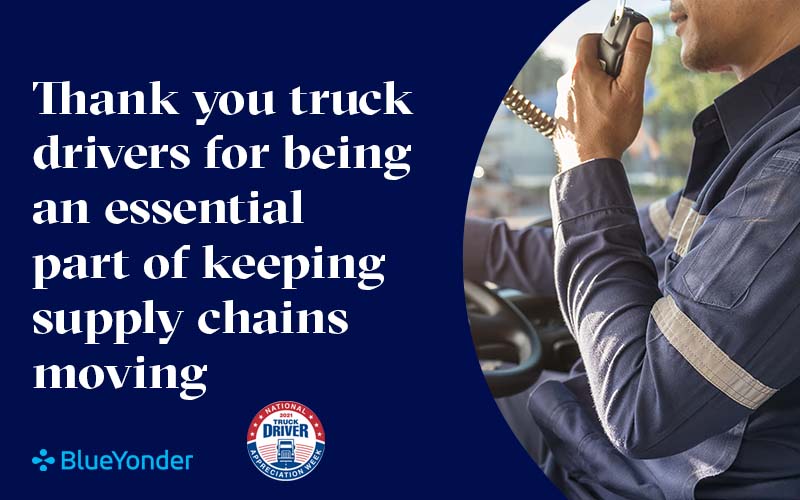Thank a Trucker; It’s National Truck Driver Appreciation Week
This blog is co-authored by Raj Patel, Senior Director Global Industry Strategy 3PL, and Terence Leung, Senior Product Marketing Director
This week is National Truck Driver Appreciation Week (Sept. 12-18). The annual event is dedicated to thanking the 3.5 million professional truck drivers for driving the economy forward. Each day, truck drivers move goods throughout the country; nearly every item consumed in the U.S. is put on a truck at some point in its route.
During the COVID-19 pandemic, this became especially important as the virus slowed the flow of goods. Truckers became essential workers getting important things like medical supplies and food to communities across the country. From the bottom of our heart, we would like to express our gratitude toward all truckers for their dedication and professionalism.
The trucking industry hauled 73% of all freight transported in the U.S. in 2019, equating to 11.84 billion tons of freight, according to the American Trucking Associations (ATA). That same year, trucking resulted in $791.7 billion in gross freight revenues (primary shipments only). In 2018, there were 304.9 billion miles traveled by all registered trucks and 184.2 billion miles traveled by combination trucks.
Meeting the Turnover Challenge
However, given all that, the turnover rate for long-haul truck drivers is staggering. Among large truck companies ($30 million-plus in annual revenue), driver turnover rates are 92%. For smaller companies, the rate is 72%. This is according to the ATA’s Quarterly Employment Report.
How can consumers continue their pace of consumption if the labor shortage is not addressed? How will logistics operations continue to move goods across the U.S., uninterrupted? Companies are trying to improve the situation through:
- Pay increases
- Retention and sign-on bonuses
- Better on-road information
- Better ways to increase driver safety
- Investment in modernized equipment
TMS Can Be One Solution to Turnover
One thing that might help the situation is when companies use a Transportation Management System (TMS) to optimize trucking routes. TMS can do more than just plan and optimize routes, it can help a trucking company motivate, retain, and reward drivers. Supply chains are only getting more complex because of the continued growth of e-commerce and the impacts of the pandemic, so putting intelligence into the design and planning of routes becomes increasingly important as companies look to offer more support for their fleet truckers to improve efficiencies and sustainability at the same time.
By designing and offering different routes, companies can improve quality of life for their own fleet drivers. For example:
- Offering choices of routes enables drivers to select what works best for them; some may want routes that keep them closer to home while others may prefer routes that take them to different places.
- Properly designed routes also allow drivers to take their breaks in areas where services are available.
For retailers who use dedicated or contract carriers, the TMS:
- Enables drivers to seamlessly update their milestones and ETA; actions that were previously carried out manually. This provides visibility into where the driver/product is when en-route, enhancing safety for the driver because it allows you to know where they are to get them help faster in case of an emergency. It also offers retailers visibility into any potential disruptions, giving you the agility to manage it better.
- Allows for quicker driver settlements since slow billing and incorrect paychecks can quickly lead to a disastrous turnover rate. Companies can ensure drivers get paid accurately and on-time by choosing a TMS with fully integrated accounting and billing capabilities.
TMS Offers Other Benefits
Finally, as the TMS plans and optimizes network moves, it produces plans for reduced miles based on realistic constraints and parameters, thus resulting in lower emissions for the entire network. This is much improved from the previous manual-based planning and/or leveraging of static route guides. Furthermore, investing in better systems like TMS, warehouse management, order management, and control tower will improve the overall picture and the key areas of driver well-being, efficiencies, sustainability.
Even though at present there is a labor shortage in the trucking industry, goods are continually being moved by the current trucking workforce thanks to their tenacity and strong work ethic – despite the many daily hurdles. And for that, the 5,400-plus Blue Yonder associates would like to show our appreciation to all truckers: for your essential service pre-pandemic, during the pandemic, and in the days and months ahead.

